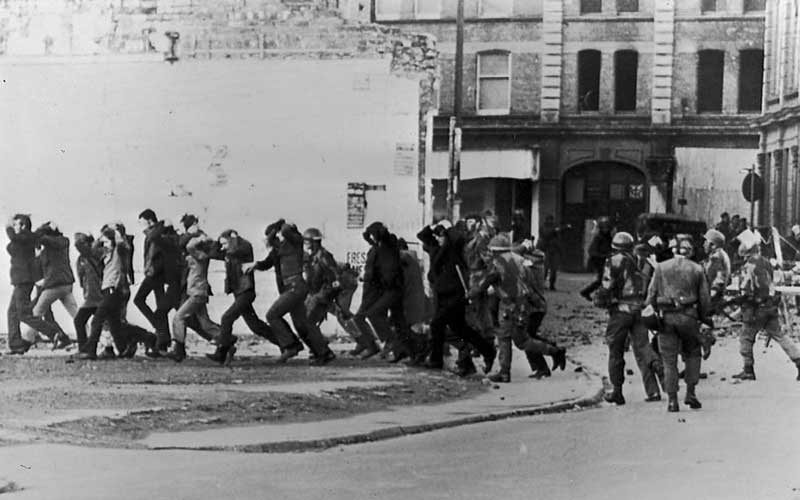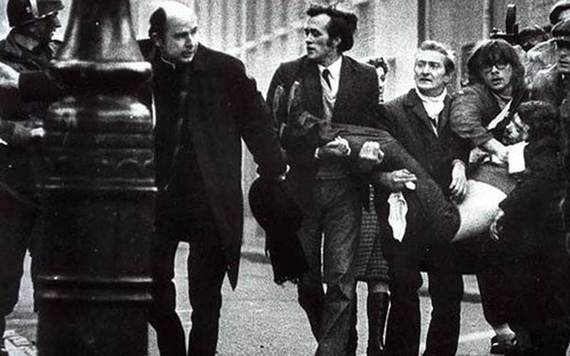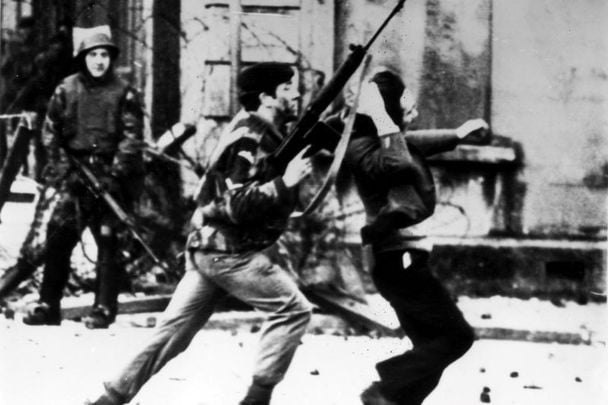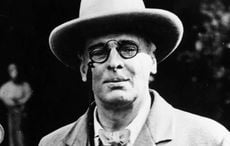It's been more than five decades since Bloody Sunday in Derry, Northern Ireland, and many questions are still unanswered.
This is a non-partisan introduction to the events on the day, for those who want to know more about what happened. If you'd prefer to listen to this, then check out The Troubles Podcast, which is available anywhere you get podcasts or by clicking here.
Background
It was 1969 in Northern Ireland and violence between Nationalists and Unionists was escalating and the unionist government was losing control. To prevent this and to help assert the authority of the government, the British army was deployed into Northern Ireland. Initially, they were welcomed by some Catholics who perceived them to be a neutral force. At the time the local police force, known as the Royal Ulster Constabulary, was considered to be biased against Catholics. It wouldn’t be long though before opinions would quickly change against the army.
Derry is the second-largest city in Northern Ireland. In 1969, the city was very poor and there was a huge inequality between Nationalists and Unionists. Derry had a nationalist majority but, due to excessive gerrymandering and a number of discriminatory laws against Catholics, the city managed to maintain Unionist leadership in all the council roles. The city was poor, housing conditions were terrible and Catholics wanted better conditions.
This is where the Northern Ireland Civil Rights Association, or the NICRA, comes into play. It was an organization set up as a non-partisan, civil rights campaign and as an alternative to military operations. In the early days, there were some Unionists in NICRA, but as Sinn Féin and the Official IRA’s influence grew in the organization, it soon became primarily composed of nationalists.
Their aims were:
- To defend the basic freedoms of all citizens.
- To protect the rights of the individual.
- To highlight all possible abuses of power.
- To demand guarantees for freedom of speech, assembly and association.
- To inform the public of their lawful rights.
At this time, internment without trial had been introduced in Northern Ireland. This meant that anyone who was suspected of being in a terrorist organization could be arrested on the spot. It was intended to completely wipe out the IRA, but a lot of innocent civilians were swooped up as part of the operation, which saw the British army smash their way into some people's homes to arrest individuals. The NICRA organized a number of marches against internment, even though marches were banned across Northern Ireland at this time, due to the threat of violence.
It was their march which occurred on Sunday, January 30, 1972, that would make headlines around the world.
The British Army
The authorities in Derry decided to allow the march to continue but wanted the army to alter the route so that the march would remain in the Catholic part of the city. At this time, there were parts of Derry that were considered ‘no-go’ areas by the British Army. The main area was known as Free Derry. Road barricades had been erected to prevent military vehicles getting through and members of the IRA carried weapons out in the open.
Brian Cashinella, a journalist who worked for the Times, said of the situation there: “It became very clear that Free Derry had become unacceptable to the British Government in London and very embarrassing to the army in Northern Ireland. And they were going to do something about it, to get rid of this anomaly, this no go area.”
Major General Robert Ford was the commander of land forces in Northern Ireland at the time and had promised that tougher measures would be introduced to deal with the lawlessness in Derry. These tougher measures came in the form of the first battalion of the Parachute Regiment. The Parachute Regiment was an elite trained regiment of the British Army. They had a reputation for being heavy-handed and were considered significantly more severe, or tough that the regular British soldier. These soldiers were the ones deployed on the day of the march against internment on Sunday, January 30, 1972.
Major Ford expected rioting on the day and deployed the Parachute Regiment to deal with the rioters. Many have suggested that this was a psychological move, to show control of the region.
Ivan Cooper who was one of the organizers of the march on the day described the paratroopers: “I also saw the paratroopers myself on a side street. They seemed to be hyped up. They were a different breed to what we had accustomed ourselves to in Derry. Tough, resolute and hyped up.”
Ivan was a staunch pacifist and had met with the leader of the Provisional IRA before the march, to confirm that they would not be armed men on the day. Ivan said: “I told him, that the march if it wasn't going to be nonviolent, that unless I could receive assurances to that effect, that I would not be continuing to support it and I would use my influence to have it called off. I was contacted again and I was told that the Provisional IRA would give an undertaking that they would not be in the vicinity of the march on the Sunday.”
It wasn’t in the interest of the Official IRA and the Provisional IRA to launch an attack on this day, as they would have been blamed for any civilian casualties if they instigated violence.
British paratroopers take away civil rights demonstrators on Bloody Sunday, January 30, 1972. Credit: Getty 
The March
It was a sunny afternoon when 10 - 15,000 people joined together to take part in the march. The march began in the housing estate of Creggan and then made its way down the Bogside, which is the largely Catholic area just outside of Derry's Old City walls.
There was a very relaxed atmosphere in the air and many people joined the march just to catch up with friends or have a chat. Meanwhile, the British Army was setting up barricades.
The Army’s plan was to erect 26 sequentially numbered barricades, one on each street, that would cut off access to the city center by the protesters. Each barricade would consist of wooden knife rests, barbed wire, and concrete slabs. They would also have a number of British soldiers and two armored personnel carriers behind each barricade.
The plan was for the army not to attack the protesters as long as they stayed in the permitted areas. If any individuals tried to breach the barriers then they were allowed to respond with rubber bullets, water cannons, and tear gas. There was also a plan to have a ‘scoop up’ operation which would see the rioters arrested once they had separated themselves from the people marching.
The march continued down the Bogside until they neared the city center and began to approach the army barriers. Because of the barriers, the organizers changed the route, intending the rally to happen at an area known as the Free Derry Corner instead. The paratroopers had set up camp in a derelict building on the side of barricade 14 and were hoping to outflank the protesters and launch an arrest operation.
It’s at this point that it is important to note that there are some drastically different narratives of what occurred after this.
There have been two enquiries into the events of the day, the Widgery Enquiry and the Saville Enquiry. Both of which will be referenced in this article. The inquiries took place 30 years apart and came to very different conclusions. The Widgery Inquiry took place directly after the shootings and many have argued that it ‘whitewashed’ the events which took place on the day and defended the soldier’s actions.
The Saville Inquiry began in 1998 and took seven years to conclude. It was then released to the public in 2010. Over 900 people were interviewed and it was the biggest investigation in British Legal History, costing 195 million pounds. I will be referencing these inquiries throughout the rest of the account.
Instead of continuing straight, the lorry then turned right to head towards the Free Derry Corner. Most of the crowd turned and followed the lorry but some continued down William St until they arrived at barrier 14. The crowd then jeered the soldiers and RUC members who manned the barrier but gradually thinned until some youths remained. The youths then began to throw stones at the troops, who responded with rubber bullets, water cannons, and tear gas. Exchanges like this were somewhat common at the time and rarely resulted in shots being fired by the soldiers.
Some individuals in the crowd noticed the paratroopers in the derelict building and just before 4 pm, they began throwing stones and bottles at them. In response, they opened fire, with real bullets. 15-year-old Damien Donaghy was throwing stones and was shot, but survived his injuries. John Johnson, 59, who was a passer-by, was also shot twice and died of his injuries four months later. The soldier who shot the two has claimed that the youths were throwing nail bombs, but no evidence of that has ever been found. A shot from a rifle was then fired at the soldiers, which hit a nearby drainpipe.
Then, at 15:55, Colonel Derek Wilford requested permission for 1 Para to "deploy sub-unit through barricade 14 to pick up yobbos in William Street/Little James Street." Yobbo is a derogatory term for a young person.
They got permission for the ‘scoop up’ operation and at ten past four, the paras entered through barrier 14. Meanwhile, ten armored personnel carriers entered through barrier 12. This was the first time British troops had entered the Bogside part of Derry in daylight in six months and they had been briefed that they may be walking into an IRA ambush.
A reporter for The Times, Brian Cashinella then explains what happened next:
“Orders were being shouted at the back of me. You could hear the orders get on board get on board. And round the corner into Williams Street came these armored personnel carriers with lots of troops in the back. The back doors were open, the troops were very heavily armed with rifles. And I was standing next to General Robert Ford at the time who was a new commander. And he was waving his swaggering stick saying, go on the paras, go and get them, go on, go and get them. From then on it was mayhem.”
The sight of the vehicles caused panic in the crowd and the Saville report concluded “that while some civilians threw stones and bottles at the vehicles as they came into the Bogside, the general reaction of the crowd was to run away.”
Some of the crowd tried to flee but ended up stuck in the courtyard of the Rossville Flats. Warning shots were fired to disperse the ‘hostile crowd’ and then the Widgery report stated that the soldiers came under fire while arresting civilians in the crowd. They responded by shooting into the crowd. John Duddy, 17, was shot in the back and died of his injuries. Father Edward Daly was beside Duddy when he was shot and attempted to bring him to get medical attention. Video footage was captured showing Father Daly waving a blood-stained handkerchief at the soldiers while trying to get Duddy to safety. The Widgery report stated that John was most likely shot by Soldier V, who claims that he was firing at someone else. I say Soldier V because the identities of the soldiers have never been released and as of writing, some of them are still alive and their identities are protected so have historically been referred to as Soldier A, Soldier B, and so on.
A wounded man is carried from the street by civil rights marchers on Bloody Sunday, Jan.30,1972. Credit: Getty 
The rest of the armored vehicles ended up on Rossvill Street and Kells Walk. At Kells Walk, the soldiers encountered men standing on a rubble barricade in the middle of the road, facing them. The soldiers claimed that these men were identified as gunmen and nail bombers and opened fire on them. Seven men were killed in this exchange.
William Nash was shot in the chest at the rubble barricade and killed. John Young and Michael McDaid ran to help William but were both shot in the face and killed. William Nash’s father, Alexander, ran forward to help his son and was shot, but survived. The Widgery report states that William’s father was shot with a low velocity round and claims that the wound was "inflicted by a civilian firing haphazardly in the general direction of the soldiers without exposing himself enough to take proper aim."
Michael Kelly, Hugh Gilmore, Kevin McElhinney, and Patrick Doherty also were killed by soldiers. Two of them were shot in the back as they attempted to crawl away.
By this stage, a group of civilians were trying to get away from the street where the shooting was taking place. Soldiers D, F, G and H then confronted them in the central courtyard of Glenfada Park north. It was here a number of civilians were shot. James Wray, 22, Gerald McKinney,35, and William McKinney, 26, were all killed and a number of other civilians were injured. Gerald Donaghy,17, was shot in the stomach and mortally wounded.
Across from the Rossville Flats, a man lay injured and was calling out for help. Bernard McGuigan, 41, rushed over to his aid, waving a white handkerchief at the British soldiers. He was immediately shot in the head and killed. It is believed that Soldier F fired the gun that killed McGuigan. We will hear more about Soldier F later.
After the shooting had stopped, the mortally wounded Ger Donaghy was brought to a nearby house where he was treated by a civilian doctor. He was then put in a car and driven to a nearby hospital. On the way, the car was stopped by a British Military checkpoint, where the driver and other passengers were arrested. The wounded Donaghy was then brought by a soldier to an army first aid post where he was pronounced dead. It was then reported that four individual nail bombs were found on his body. The civilians who searched him, the soldier who drove him to the Army post, and the Army medical officer, all said that they did not see any bombs on him, which has led to speculation that they were planted by the army. The Saville Inquiry concluded that Donaghy probably had the bombs in his possession but was not about to throw them. He was not shot because he had the bombs, he was shot in the back as he was trying to flee the soldiers.
It was important for the British army to find evidence that they had been fired upon and that they were defending themselves. Otherwise, it would look like they massacred defenseless civilians. The Saville Inquiry found that no proof of gunfire or nail bombs being thrown at them.
The soldiers had been shooting for 18 minutes and 26 unarmed civilians had been shot. 14 of them died. No British soldiers were injured.

Love Irish history? Share your favorite stories with other history buffs in the IrishCentral History Facebook group.
The Aftermath
In England, Bloody Sunday was discussed in the House Of Commons and the position of the army was that they had responded to attacks against them, though all non-military, eyewitness accounts on the day, mention how the soldiers had fired into an unarmed crowd.
People in the Republic of Ireland were absolutely furious with the events of Bloody Sunday. When the bodies of the victims were buried on the second of February, there was a general strike in the Republic. An angry crowd also burnt down the British Embassy in Dublin.
It has been argued that Bloody Sunday was the first event to really kick off the Troubles in Northern Ireland. There had been plenty of violence before but this was different. This was the mass killing of civilians by soldiers and in full view of the media. It fueled hostilities on the nationalist side and led to an uptick in the number of people joining Nationalist paramilitary organizations. The Original IRA and Sinn Féin were moving towards Marxism at this time, which paved the way for a surge in membership to the Provisional IRA among disaffected and angry young people.
The soldiers who were interviewed all had detailed recollections of being fired upon first but most of these accounts have since been discredited. There have been accounts of one individual firing a revolver at the soldiers before civilians in the crowd ushered him away.
The attitude towards the soldiers is very different in the two Inquiries. The Widgery Inquiry states of the soldiers involved:
"Those accustomed to listening to witnesses could not fail to be impressed by the demeanor of the soldiers of 1 Para. They gave their evidence with confidence and without hesitation or prevarication and withstood a rigorous cross-examination without contradicting themselves or each other. With one or two exceptions I accept that they were telling the truth as they remembered it."
Then, 30 years later, the Saville Inquiry concluded:
"In the course of the report, we have considered in detail the accounts of the soldiers whose firing caused the casualties, in the light of much other evidence. We have concluded, for the reasons we give, that apart from Private T many of these soldiers have knowingly put forward false accounts in order to seek to justify their firing."
The Saville came to the conclusion that the soldiers lost their self-control. It said:
"In this belief soldiers reacted by losing their self-control and firing themselves, forgetting or ignoring their instructions and training and failing to satisfy themselves that they had identified targets posing a threat of causing death or serious injury … our overall conclusion is that there was a serious and widespread loss of fire discipline among the soldiers of Support Company."
The Saville Report
When the Saville report was released to the public on June 15, 2010, thousands of people walked the same route in Derry that the marchers did 38 years earlier. They held photos of the individuals who lost their lives in the attacks and copies of the Widgery report were ripped up.
The Saville report made a number of conclusions:
- The soldiers should have never been ordered to enter the Bogside.
- Five British Soldiers shot at civilians who they knew did not pose a threat.
- Two British Soldiers shot at civilians "in the belief that they might have identified gunmen, but without being certain that this was the case"
- The soldiers fired first after hearing warning shots fired by Lieutenant N, believing the IRA to be responding to them entering the Bogside.
Soldier F
Families of the victims have continued to campaign for justice for their loved ones. In 2019, Soldier F was charged with two counts of murder, in the case of James Wray and William McKinney, who were both shot in the back. He was also charged with four counts of attempted murder. In December 2024, Soldier F pleaded not guilty to the two attempted murders; a trial date is pending.
Many Unionists still voice their support for the paratroopers and, in particular, Soldier F. There have been a number of incidents where the flag for the Parachute Regiment has been flown in Northern Ireland, as a sign of defiance against Nationalists and support for the troops involved in Bloody Sunday.
After the release of the Inquiry, the British Prime Minister at the time, David Cameron, apologized on behalf of the British government, saying:
"I am deeply patriotic. I never want to believe anything bad about our country. I never want to call into question the behaviour of our soldiers and our army, who I believe to be the finest in the world. And I have seen for myself the very difficult and dangerous circumstances in which we ask our soldiers to serve. But the conclusions of this report are absolutely clear. There is no doubt, there is nothing equivocal, there are no ambiguities. What happened on Bloody Sunday was both unjustified and unjustifiable. It was wrong."
*Originally published in January 2023. Updated in January 2025.
This article was submitted to the IrishCentral contributors network by a member of the global Irish community. To become an IrishCentral contributor click here.




Comments